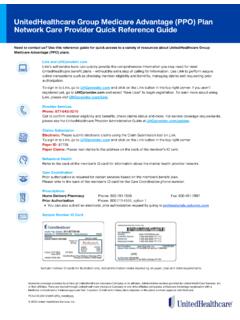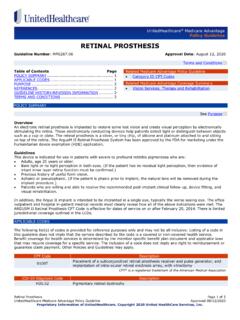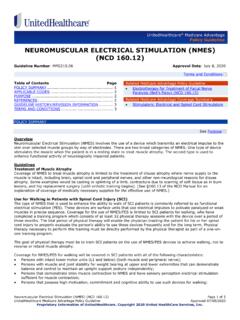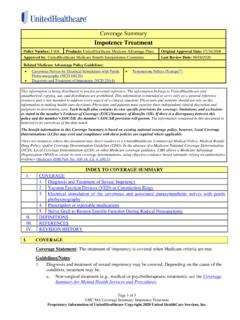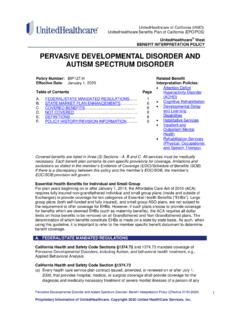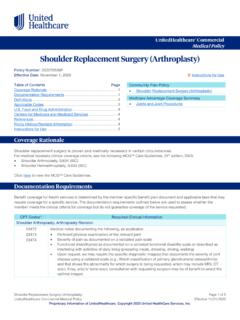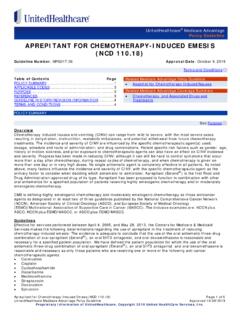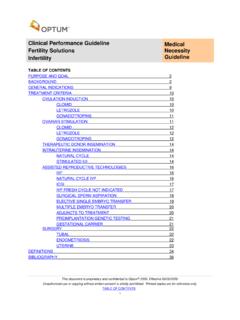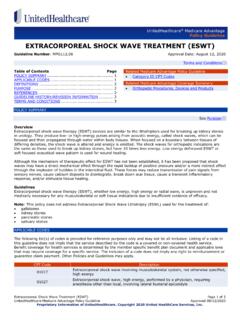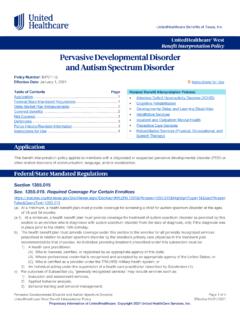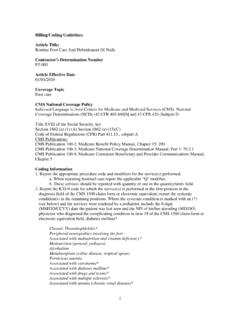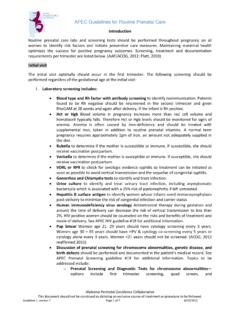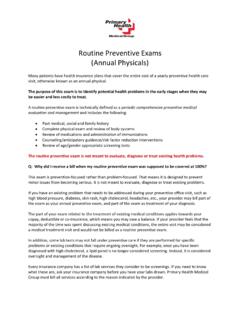Transcription of Podiatry – Medicare Advantage Policy Guideline
1 UnitedHealthcare Medicare Advantage Policy Guideline Podiatry Guideline Number: Approval Date: December 8, 2021 Terms and Conditions Table of Contents Page Related Medicare Advantage Policy Guideline Policy Summary .. 1 Services Provided for the Diagnosis and Treatment Applicable Codes .. 2 of Diabetic Sensory Neuropathy with Loss of Definitions .. 3 Protective Sensation (aka Diabetic Peripheral References .. 4 Neuropathy) (NCD ). Guideline History/Revision Information .. 5. Purpose .. 6 Related Medicare Advantage Coverage Summary Terms and Conditions .. 6 Foot care Services Policy Summary See Purpose Overview Generally, routine foot care is excluded from Medicare coverage except for the following conditions or situations: Necessary and integral part of otherwise covered services o Diagnosis and treatment of ulcers, wounds or infections o Trimming or cutting nails to be fitted with a cast following a fracture (if the cast is a separately billable service).
2 Presence of systemic conditions o Metabolic, neurologic or peripheral vascular disease that may require scrupulous foot care by a professional Treatment of warts on foot o Treatment of warts, including plantar warts, on the foot is covered to the same extent as services provided for treatment of warts located elsewhere on the body Mycotic Nails: In the absence of a systemic condition, treatment of mycotic nails may be covered, only when the following criteria are met: o Ambulatory patient Clinical evidence of mycosis of the toenail and Patient has marked limitation of ambulation, pain or secondary infection resulting from thickening and dystrophy of the infected toenail plate o Non-ambulatory patient Clinical evidence of mycosis of the toenail and Patient suffers from pain or secondary infection resulting from the thickening and dystrophy of the infected toenail plate Covered exceptions to routine foot care services are considered medically necessary once (1) in 60 days.
3 Routine foot care services performed more often than every 60 days will be denied unless documentation is submitted with the claim to substantiate the increased frequency. guidelines Codes and policies for routine foot care and supportive devices for the feet are not exclusively for the use of Podiatrists. These codes must be used to report foot care services regardless of the specialty of the physician who furnishes the services. Physicians should use the most appropriate code available when billing for routine foot care . Podiatry Page 1 of 6. UnitedHealthcare Medicare Advantage Policy Guideline Approved 12/08/2021. Proprietary Information of UnitedHealthcare. Copyright 2021 United HealthCare Services, Inc. Relatively few claims for routine-type care are anticipated considering the severity of conditions contemplated as the basis for this exception. Claims for this type of foot care should not be paid in the absence of convincing evidence that nonprofessional performance of the service would have been hazardous for the beneficiary because of an underlying systemic disease.
4 The mere statement of a diagnosis such as those mentioned above does not of itself indicate severity of the condition. Where development is indicated to verify diagnosis and/or severity, records may be requested to review the history and medical conditions of the patient as well as any physician contacts for management of those conditions. Q Modifiers (Q7, Q8, and Q9) are utilized to denote Class A (Q7), Class B (Q8) and Class C (Q9) findings. These modifiers may be used with procedure codes 11055, 11056, 11057, 11719, 11720, 11721 or G0127. When a Q7, Q8, or Q9 modifier is used, the provider must document in the medical record the appropriate signs and symptoms as outlined in Class Findings A, B, and/or C along with the complicating condition(s). Hyperkeratotic Lesions Coding Criteria Procedure Code 11055, 11056, or 11057 are included in Medicare 's covered foot care service when billed with a diagnosis pertaining to hyperkeratotic lesions.
5 Refer to the Diagnosis Code List. Nondystrophic Nails Coding Criteria Procedure Code 11719 is included in Medicare 's covered foot care when billed with a diagnosis pertaining to nondystrophic nails. Refer to the Diagnosis Code List. Debridement of Nail Coding Criteria Procedure Code 11720 or 11721 are included in Medicare 's covered foot care when billed with a diagnosis pertaining to debridement of nail. Refer to the Diagnosis Code List. Dystrophic Nails Coding Criteria Procedure Code G0127 is included in Medicare 's covered foot care when billed with a diagnosis pertaining to dystrophic nails. Refer to the Diagnosis Code List. Diabetic Sensory Neuropathy with LOPS Coding Criteria Diabetic sensory neuropathy with LOPS is a localized illness of the feet and falls within the regulation's exception to the general exclusionary rule (see 42 CFR (l) (1) (i)). Foot exams for people with diabetic sensory neuropathy with LOPS are reasonable and necessary to allow for early intervention in serious complications that typically afflict diabetics with the disease.
6 For additional information, please reference the Medicare Advantage Policy Guideline titled Services Provided for the Diagnosis and Treatment of Diabetic Sensory Neuropathy with Loss of Protective Sensation (aka Diabetic Peripheral Neuropathy) (NCD. ). Applicable Codes The following list(s) of procedure and/or diagnosis codes is provided for reference purposes only and may not be all inclusive. Listing of a code in this Guideline does not imply that the service described by the code is a covered or non-covered health service. Benefit coverage for health services is determined by the member specific benefit plan document and applicable laws that may require coverage for a specific service. The inclusion of a code does not imply any right to reimbursement or guarantee claim payment. Other Policies and guidelines may apply. CPT Code Description 11055 Paring or cutting of benign hyperkeratotic lesion ( , corn or callus); single lesion 11056 Paring or cutting of benign hyperkeratotic lesion ( , corn or callus); 2 to 4 lesions 11057 Paring or cutting of benign hyperkeratotic lesion ( , corn or callus); more than 4 lesions 11719 Trimming of non-dystrophic nails, any number Podiatry Page 2 of 6.
7 UnitedHealthcare Medicare Advantage Policy Guideline Approved 12/08/2021. Proprietary Information of UnitedHealthcare. Copyright 2021 United HealthCare Services, Inc. CPT Code Description 11720 Debridement of nail(s) by any method(s); 1 to 5. 11721 Debridement of nail(s) by any method(s); 6 or more CPT is a registered trademark of the American Medical Association HCPCS Code Description G0127 Trimming of dystrophic nails, any number G0245 Initial physician evaluation and management of a diabetic patient with diabetic sensory neuropathy resulting in a loss of protective sensation (LOPS) which must include: (1) the diagnosis of LOPS, (2) a patient history, (3) a physical examination that consists of at least the following elements: (a) visual inspection of the forefoot, hindfoot, and toe web spaces, (b) evaluation of a protective sensation, (c). evaluation of foot structure and biomechanics, (d) evaluation of vascular status and skin integrity, and (e).
8 Evaluation and recommendation of footwear, and (4) patient education. (See the Medicare Advantage Policy Guideline for Services Provided for the Diagnosis and Treatment of Diabetic Sensory Neuropathy with Loss of Protective Sensation (AKA Diabetic Peripheral Neuropathy) (NCD )). (Deleted 10/13/2021). G0246 Follow-up physician evaluation and management of a diabetic patient with diabetic sensory neuropathy resulting in a loss of protective sensation (LOPS) to include at least the following: (1) a patient history, (2). a physical examination that includes: (a) visual inspection of the forefoot, hindfoot, and toe web spaces, (b) evaluation of protective sensation, (c) evaluation of foot structure and biomechanics, (d) evaluation of vascular status and skin integrity, and (e) evaluation and recommendation of footwear, and (3) patient education. (See the Medicare Advantage Policy Guideline for Services Provided for the Diagnosis and Treatment of Diabetic Sensory Neuropathy with Loss of Protective Sensation (AKA Diabetic Peripheral Neuropathy) (NCD )) (Deleted 10/13/2021).
9 G0247 Routine foot care by a physician of a diabetic patient with diabetic sensory neuropathy resulting in a loss of protective sensation (LOPS) to include the local care of superficial wounds ( , superficial to muscle and fascia) and at least the following, if present: (1) local care of superficial wounds, (2) debridement of corns and calluses, and (3) trimming and debridement of nails. (See the Medicare Advantage Policy Guideline for Services Provided for the Diagnosis and Treatment of Diabetic Sensory Neuropathy with Loss of Protective Sensation (AKA Diabetic Peripheral Neuropathy) (NCD )) (Deleted 10/13/2021). Modifier Description Q7 One Class A finding Q8 Two Class B findings Q9 One class B and 2 class C findings Diagnosis Code Podiatry : Diagnosis Code List Definitions Class A Findings: Nontraumatic amputation of the foot or integral skeletal portion thereof. Class B Findings: Absent posterior tibial pulse, advanced trophic changes and absent dorsalis pedis pulse.
10 Class C Findings: Claudication, temperature changes, edema, paresthesias and burning. LOPS: Loss of Sensory Protection from Diabetic Neuropathy. Mycotic: Evidence of mycosis of the toes characterized by one or more of the following: thickness, thinness, discoloration, looseness, destruction or lysis, misshapenness of the nail and/or nail bed. Podiatry Page 3 of 6. UnitedHealthcare Medicare Advantage Policy Guideline Approved 12/08/2021. Proprietary Information of UnitedHealthcare. Copyright 2021 United HealthCare Services, Inc. Podiatry : Treatment of disorders/ailments of the foot, heel, ankle and leg by medical, orthopedic and surgical means by a Medical Doctor (MD, DO), Orthopedic Doctor (OD), or Doctor of Podiatric Medicine (DPM). Q7: Modifier used when there is one Class A finding. Q8: Modifier used when there are two Class B findings. Q9: Modifier used when there is one Class B finding and two Class C findings. References CMS National Coverage Determinations (NCDs).
